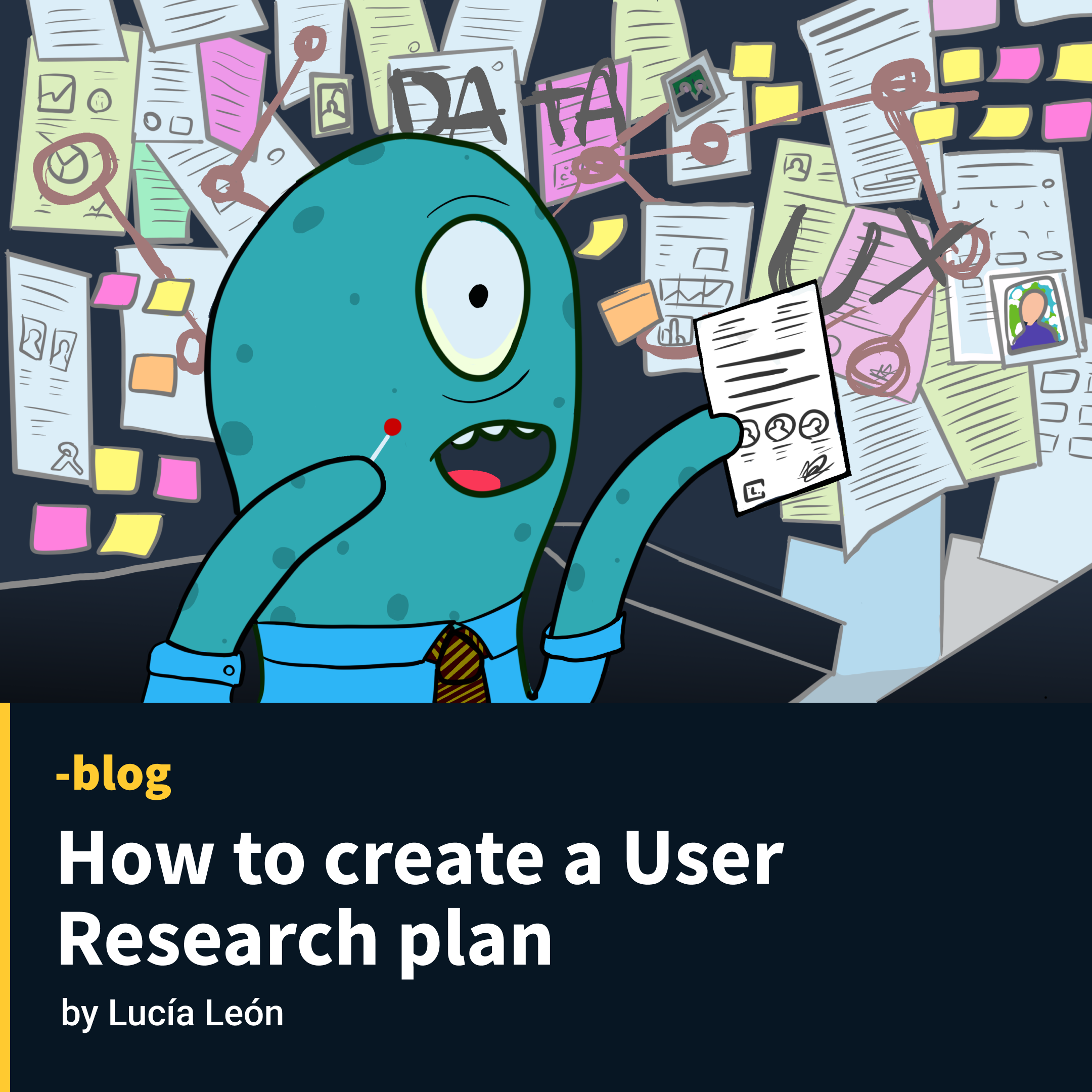User research is an essential part of UX design. What all user research has in common is that it helps place people at the center of your design process and your products.
📌 It’s a good idea to kick things off by making a research plan.
8 steps on how to create a User Research Plan.
Why creating a plan matters:
Creating a research plan structures your thinking around the research activity and will help you think through every step of your research project and give you something to refer back to while doing the research. Plans minimize the need for meetings while keeping stakeholders informed and participating. Your research project planning should be documented to avoid misunderstandings and prevent unnecessary rework.
Your research plan should cover the following:
- Research purpose
- Identify your objectives
- Research Method
- Who will participate
- The location for the research and what equipment you will use
- What data you will collect, and how you analyze it
- A script for how you will run the study and what you will say
- How you plan to handle consent
- How you plan to communicate about the research
- Your time plan
Let’s dive into each item
1. Research purpose
Write down in a few sentences the overall question you want to answer.
Example: “The purpose of this UX research plan is to gather data on user needs and behaviors in order to inform the design and development of a new e-commerce website for our company. The research will focus on understanding the user journey, identifying pain points, and gathering feedback on proposed design solutions.”
2. Identify your objectives
After determining the purpose or problem statement, consider the following study objectives:
What you’re doing, why you’re doing it, and what you expect from the user research.
For example:
- Understanding user needs and goals: Understanding what users want to accomplish with a product or service, what problems are they trying to solve, and what their pain points are.
You can ask yourself a series of questions to get closer to the goal of user research, using the 5 Whys method is a good option.
Here’s an example of how 5 Whys can be applied:
Problem: Customers are not returning to our website.
Why? They are not finding the information they need Why? The navigation is confusing and hard to use. Why? The website was not user-tested before it was launched.
3. Method
What’s the best way to answer the overall question?
When determining the best approach, we must consider the availability of resources (financial and time) and the most effective method for obtaining the desired information.
We can use observation, conduct an online survey with many participants, or conduct a limited number of user interviews. Each method has advantages and disadvantages and requires varying levels of resources. Therefore, we must balance these factors to choose the most appropriate approach.
Example of selected method: User Interviews: We will conduct in-person interviews with 15 users who match our target demographic. The interviews will last approximately 45 minutes each and will be conducted by trained research facilitators. We will ask open-ended questions about their current experience using similar e-commerce websites and gather feedback on the wireframes of our proposed design solutions.
Learn more about research methods
4. Participants
It is essential to specify the characteristics of the participants for the study and outline the strategy for acquiring them. This includes identifying the demographic profile of the participants and the methods used to recruit them.
For example:
- Demographic: Male and female adult shoppers (ages 25-55) who have recently purchased home appliances online.
- Recruitment: We will recruit participants through online surveys distributed to individuals who have recently made a purchase on our website and through targeted outreach to individuals who match our target demographic profile on social media platforms and online forums. We will incentivize participants to take part in the study.
⚠️ Be aware that getting the right participants is crucial.
5. Data and Analysis
A vital aspect of designing a user study is determining the types of data to collect and the methods of analysis to be used.
The selection of data to collect depends on the chosen method and the intended objectives of the analysis. The type of data collected will determine the range of possible analyses and, therefore, the potential outcomes.
For example: If you’re doing a usability test, you might record the time to complete tasks, number of errors, and similar things. You might record video, sound, or take notes if you’re doing interviews.
Often there are multiple ways to analyze your data. When you decide on an analysis method, you must consider what’s appropriate for the research method you’ve chosen, what form of results you’d like to get, and how you’ll use the results.
No matter what your project is, you should note in your research plan document what “data” you’re going to collect and how you’re going to do it, as well as the “type of analysis” you plan to do.
For example, We will use a standardized interview guide during the user interviews to ensure consistency across all discussions. We will also use a recording device to capture the audio of the interview and take detailed notes of the participants’ responses.

6. The script
It would be best if you wrote a script for how you run the study.
First, write down an introduction of yourself and the study. Writing it down will help you think through what you need to say and show that you’re giving all participants the same information and give you something to refer to when running the study.
For example:
Introduction:
- Introduce yourself and the purpose of the interview.
- Explain the process of the meeting and the expected duration.
- Obtain informed consent from the participant.
Warm-up Questions:
- Ask a few general questions to help the participant feel more comfortable and to help break the ice. Examples: “Can you tell me about your recent online shopping experience?”
- “What are some of your favorite online stores?”
Main Questions:
- Ask a set of questions that are directly related to the research goals and objectives. Examples: “Can you walk me through your experience using our e-commerce website?” “What pain points or frustrations have you experienced while shopping online?” “Can you provide feedback on these proposed design solutions?”
Closing Questions:
- Ask a few closing questions, such as “Is there anything else you’d like to add?” or “Do you have any questions for me?”
- Thank the participant for their time and remind them how they can contact you if they have further questions or feedback.
Write down the questions you want to ask and if you’re doing a test, the tasks that the participants have to perform.
7. Consent
Even if your research is not focused on sensitive personal information, you must get your participant’s consent to participate in your study. When getting the approval, you should always inform participants of the overall purpose of your research, if you are recording them, and with whom you’ll share the recordings. You should also tell the participants that their participation in your study is “completely voluntary”. They can quit at any time they feel.
You can use a written consent form detailing the relevant information the participant signs to verify that they consent to take part in your study or you can give the information verbally. Whether you need to get their written consent “differs from country to country” and also depends on your research project.
8. Time planning
Once you’ve decided on the basic practicalities of your research, you can make a time plan. Go through all the steps you’ve outlined, and think about how much time you’ll need to carry out each step. This process will give you an idea of when to start recruiting participants, when the study can happen, and when you can provide your results.
After you have an idea of the timeline, you can schedule individual sessions with participants. A good way to show how much time is needed is by putting together a roadmap for each step of the plan.
💡 A good tip is to do a test run of the study with a friend or colleague to get an idea of how long each session will take.
Conclusion
Creating a user research plan is a critical aspect of conducting a successful research study.
Provides a clear and organized framework for conducting the research, ensuring that all important aspects are considered and addressed.
References and where to learn more:





